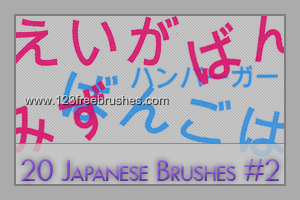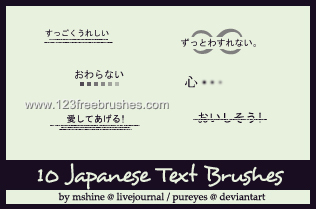
Dec 08, · In this quick video, we will be taking a look at how to create a Japanese brush font text effect in Adobe Photoshop. Creating a completely custom, from scrat Aug 20, · Use tate‑chu‑yoko. Tate‑chu‑yoko (also called kumimoji and renmoji) is a block of horizontal type laid out within vertical type lines. Using tate‑chu‑yoko makes it easier to read half-width characters such as numbers, dates, and short foreign words in Oct 21, · Finally, let’s move on to creating our Japanese-inspired text effect. Step 1. This first step is optional, but it might help you out for your first few tries with this effect! Choose a font that's similar to the structure you want your text to have. In this case, the Japanese brush font “Little Samurai” works perfectly. Type out your word or blogger.com: Abbey Esparza
Japanese fonts in Photoshop? - Content - SitePoint Forums | Web Development & Design Community
Photoshop provides several options for working with Chinese, Japanese, and Korean type. Your operating system must support the languages in which you wish to work.
Consult your system software manufacturer for more information. By default, non-Chinese, Japanese, or Korean versions of Photoshop hide options for Asian type that appear in the Character panel and Paragraph panel. How to write japanese text in photoshop view and set options for working with Chinese, Japanese, and Korean type in these versions of How to write japanese text in photoshop, you must select Show Asian Text Options in the Preferences dialog box.
You can also control how font names are displayed—in English or in the native language. Show Font Names In English. East Asian Photoshop and Photoshop CS6 or Show Asian Text Options CS5. Tsume reduces the space around a character by a specified percentage value.
As a result, the character itself is not stretched or squeezed. When tsume is added to a character, spacing around both sides of the character is reduced by an equal percentage.
Top-to-top Leading. Measures the spacing between lines of type from the top of one line to the top of the next line. Bottom-to-bottom Leading. For horizontal type, measures the space between lines of type from the type baseline. When you use bottom-to-bottom leading, space appears between the first line of type and the bounding box. A check mark indicates which option is selected.
The leading option you choose does not affect the amount of leading between lines, only how the leading is measured. Mojisoroe is the alignment of characters in Asian type. When a line of text contains different sizes of characters, you can specify how to align text to the largest characters in the line: to the top, center, or bottom of the em box right, center, and left for vertical framesto the roman baseline, or to the top or bottom of the ICF box right or left for vertical frames.
ICF Ideographic Character Space is the average height and width used by the font designer to design the ideographic characters that comprise a font. Small characters aligned to the bottom B. Small characters aligned to the center C. Small characters aligned to the top. Roman Baseline. Aligns the small characters in a line to the ICF specified by the large characters.
It is usually best to use any weights of KozMinPro and KozGoPro OpenType fonts. These fonts have the largest collection of glyphs of the Asian fonts produced by Adobe. On an existing type layer, select the characters or type objects to which you want to apply the setting. Mac OS From the Input pop-up menu at the right side of the menu bar, choose Show Character Viewer. Windows In Character Map, select the Advanced View option, choose All from the Group By menu, and then choose Unicode for Character Set.
View menu B. Font menu C. Character Information D. Insert With Font button. Windows Select the character you want to use, click Select, click Copy, and then paste it in Photoshop. Japanese Expert. Japanese Traditional. Proportional Metrics. Substitutes the standard kana glyph with the horizontally optimized kana glyph for horizontal layout. However, the differences are often very subtle.
Roman Italics. For more information, see Apply OpenType features, how to write japanese text in photoshop. Mojikumi specifies Japanese text composition for spacing of Japanese characters, roman characters, punctuation, special characters, line start, line end, and numbers. Mojikumi Set 1. Mojikumi Set 2. Mojikumi Set 3. Mojikumi Set 4. Kinsoku shori specifies line breaks for Japanese text. Characters that cannot begin a line or end a line are known as kinsoku characters.
Weak kinsoku sets omit long vowel symbols and small hiragana characters. JIS Weak or JIS Maximum. Push In First. Moves characters up to the previous line to prevent prohibited characters from ending or beginning a line. Push Out First. Moves characters down to the next line to prevent prohibited characters from ending or beginning a line.
Push Out Only. Always moves characters down to the next line to prevent prohibited characters from ending or beginning a line. A push-in is not attempted. Forces punctuation how to write japanese text in photoshop the bounding box by spreading lines that end within the bounding box and end with one of the hanging characters, how to write japanese text in photoshop. Legal Notices Online Privacy Policy.
Adobe How to write japanese text in photoshop iPad Features Features What's New Photoshop Brushes Content-Aware Fill Photo Effects. Buy now. Asian type Search. Last updated on Photoshop User Guide Introduction to Photoshop Dream it.
Make it. x Photoshop on the iPad System requirements 2. Display and set Asian type options. Select from the following options:. Displays Asian font names in English. Displays Asian type options in the Character and Paragraph panels. Reduce spacing around Asian type characters. Select the characters you want to adjust. In the Character panel, how to write japanese text in photoshop, enter or select a percentage for Tsume. The greater the percentage, the tighter the compression between characters.
Specify how leading is measured in Asian type. Select the paragraphs you want to adjust. Choose a leading option from the Paragraph panel menu. Select the characters you want to rotate. A check mark indicates that the option is turned on. Align Asian characters with mojisoroe. In the Character panel menu, choose an option from the Character Alignment submenu:.
Aligns the small characters in a line to the large character. Specify left and right underlining with Asian type. Select vertical type. Choose either Underline Left or Underline Right from the Character panel menu. Set Asian OpenType font attributes. With the Type tool selected, do one of the following:. Click on the image to create a new type layer. In the Character panel, make sure that an Asian OpenType Pro font is selected.
From the Character panel menu, choose an OpenType option, how to write japanese text in photoshop. Turn on the MSIME Windows or Kotoeri Mac OS input method. Do one of the following:.
Mac OS In the Kotoeri Character panel, select Glyph from the View menu. Choose an Asian OpenType font from the Font menu. Mac OS Double-click the character you want to use to insert it into your document. Asian OpenType options. Additional OpenType options are available, depending on the font.
How To Wrap Text Around A Circle with Photoshop
, time: 5:46Work with Asian type

Apr 26, · Photoshop Elements provides several options for working with Asian type. Asian fonts are often referred to as double-byte fonts or CJK fonts, meaning Chinese, Japanese, and Korean fonts. In Windows, choose Edit > Preferences > Type. In Mac OS, choose Photoshop Elements > Preferences > Type. Set text options Oct 21, · Finally, let’s move on to creating our Japanese-inspired text effect. Step 1. This first step is optional, but it might help you out for your first few tries with this effect! Choose a font that's similar to the structure you want your text to have. In this case, the Japanese brush font “Little Samurai” works perfectly. Type out your word or blogger.com: Abbey Esparza Aug 20, · Use tate‑chu‑yoko. Tate‑chu‑yoko (also called kumimoji and renmoji) is a block of horizontal type laid out within vertical type lines. Using tate‑chu‑yoko makes it easier to read half-width characters such as numbers, dates, and short foreign words in
No comments:
Post a Comment